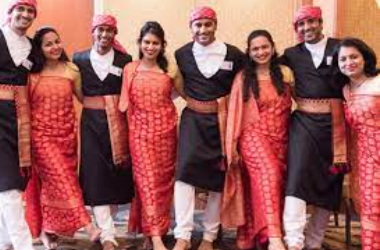Exploring the Rich Heritage: The Traditional Dress of Karnataka
karnataka state dress Karnataka, a state nestled in the southern part of India, is renowned for its rich cultural heritage. One of the most captivating aspects of Karnataka’s culture is its traditional dress. In this article, we will delve into the intricacies of the traditional attire of Karnataka, shedding light on its historical significance, regional variations, and the role it plays in preserving the state’s cultural identity.
Karnataka State Dress: An Introduction
The traditional dress of Karnataka, often referred to as “Karnataka State Dress,” is a reflection of the state’s diverse and vibrant culture. It is an embodiment of tradition, elegance, and a deep sense of identity. The term “Karnataka State Dress” is a nod to the state’s commitment to preserving its cultural roots.
The Men’s Attire
Let’s start by examining the traditional attire worn by men in Karnataka. The quintessential clothing for men is the ‘Pancha’ or ‘Dhoti.’ The Pancha is a simple yet graceful piece of clothing that consists of a rectangular piece of fabric tied around the waist. It is usually paired with an upper garment known as the ‘Angavastram’ or ‘Uttariya.’ The Angavastram can vary in colour and design, and it is often draped over one shoulder.
The Pancha and Angavastram together create a dignified and traditional look for men in Karnataka. This attire is not only comfortable but also showcases the rich cultural heritage of the state.
The Women’s Attire
Moving on to the traditional dress of women in Karnataka, we find an array of colourful and intricate garments. The most prominent attire for women is the ‘Saree.’ However, the style of draping the saree varies across different regions of Karnataka.
Kasuti Saree
One of the most famous sarees in Karnataka is the Kasuti saree. Originating from the Dharwad region, the Kasuti saree is renowned for its intricate embroidery work. The saree is characterised by patterns of dots and dashes, which are meticulously hand-embroidered, creating stunning designs. The Kasuti saree is a testament to the artistry and craftsmanship of Karnataka’s weavers.
Ilkal Saree
In the northern part of Karnataka, particularly in the town of Ilkal, the Ilkal saree holds a special place in the hearts of the local women. These sarees are known for their unique colour combinations and the distinctive use of pallu patterns. Ilkal sarees are typically woven with cotton and are an epitome of comfort and elegance.
The Grace of Accessories
No traditional dress is complete without its accompanying accessories. In Karnataka, men often adorn themselves with a ‘Mysore Peta,’ a traditional turban that signifies dignity and pride. Women, on the other hand, enhance their sarees with exquisite jewellery, including ‘Lakshmi Kasu’ necklaces and ‘Bangles.’ These accessories add a touch of grandeur to the overall look.
Regional Variations
Karnataka is a diverse state with distinct regions, each contributing its unique flavour to the traditional dress.
North Karnataka
In the northern regions of Karnataka, you’ll find the influence of Maratha and Marwari cultures. Here, men often prefer the ‘Kurta Pyjama’ alongside the traditional Pancha, while women favour the Ilkal and Kasuti sarees.
South Karnataka
In contrast, the southern parts of Karnataka embrace the ‘Lugade’ style for women. The Lugade is a unique way of draping the saree, making it easy to work in the fields. Men in this region prefer the ‘Mundu’ or ‘Veshti’ instead of the Pancha.
Coastal Karnataka
Coastal Karnataka, blessed with beautiful beaches, has its distinct charm. The traditional dress here is influenced by the coastal lifestyle, with men wearing the ‘Panche’ and women donning the ‘Saree’ in a typical coastal style.
Historical Significance
The traditional dress of Karnataka carries profound historical significance. It is a testament to the state’s rich heritage and the influence of various dynasties and cultures that have left their mark on Karnataka over the centuries.
The Pancha, for instance, has its roots in the attire worn by ancient warriors and scholars. It symbolizes valor and wisdom. The saree, with its myriad styles, has evolved over time, reflecting the changing societal norms and fashion trends.
Preserving Cultural Identity
In the modern era, as fashion trends evolve rapidly, it is heartening to see that the people of Karnataka continue to embrace their traditional dress with pride. It is not merely clothing; it is a symbol of their cultural identity and a connection to their roots.
By wearing their traditional dress on special occasions and festivals, the people of Karnataka are not only preserving their heritage but also passing it on to the younger generations. It is a reminder of the values and traditions that have been cherished for centuries.
Conclusion
In conclusion, the traditional dress of Karnataka, often referred to as “Karnataka State Dress,” is a beautiful tapestry woven with history, culture, and diversity. From the graceful Pancha and Angavastram for men to the elegant sarees like Kasuti and Ilkal for women, Karnataka’s traditional attire is a celebration of its rich heritage.
This attire not only reflects the historical significance but also serves as a powerful means of preserving the state’s cultural identity. As Karnataka continues to embrace its traditions, the traditional dress remains a testament to the enduring spirit of this vibrant state.
So, the next time you visit Karnataka or attend a traditional event, take a moment to admire the beauty and significance of the attire worn by the people of this enchanting state. In Karnataka, tradition is not just a relic of the past; it is a living, breathing part of the present and the future.
Authority Links:
Remember, the traditional dress of Karnataka is not just clothing; it’s a living testament to the state’s rich heritage and cultural diversity. Embracing tradition while evolving with the times, Karnataka continues to shine as a beacon of tradition and cultural pride.
Read more: Exploring the Essence: The Traditional Attire of Karnataka

